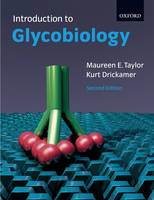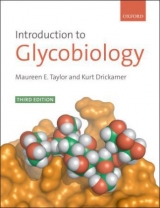
Introduction to Glycobiology
Oxford University Press (Verlag)
978-0-19-928278-4 (ISBN)
- Titel erscheint in neuer Auflage
- Artikel merken
We are all familiar with sugar as a vital source of energy. Yet the biological importance of the sugars extends way beyond their value as a cellular fuel. Introduction to Glycobiology reveals the true impact of the sugars on biological systems, explaining their functions at the molecular, cellular, and organismal level. With a new two-part structure, the book leads us through the essential principles and concepts upon which the discipline is grounded, before exploring the diverse roles of sugars throughout biological systems, including development, cell signalling, and protein trafficking. It also describes the importance of glycobiology in disease, and explains how an understanding of the link between the two is enabling us to develop new therapeutic strategies. Taking the student from the fundamental principles to the frontiers of the subject, and with more learning features to get the most from their studies, Introduction to Glycobiology remains the ideal resource for students and teachers alike. Online Resource Centre For Lecturers: - Full Colour figures to fully engage their students during classes.
For Students: - Hyperlinks to the primary literature, and full articles from appropriate OUP journals, to facilitate access to these additional resources - 3D models of key structures, to help students visualize structures, and gain a proper appreciation of the link between structure and function. - Answers to problems, to aid assessment. - Updates - surveys of key developments in the field, provided on a six-monthly basis, to maintain the currency of the resource.
Maureen Taylor gained her BSc from King's College, University of London and went on to study for her PhD at the University of London. She was a Postdoctoral Research Fellow at Columbia University, University Research Lecturer at the Glycobiology Institute in the Department of Biochemistry. She is now Research Lecturer in the Division of Molecular Biosciences at Imperial College London and also Fellow and Tutor in Biochemistry at Exeter College Oxford. Kurt Drickamer studied for his BS at Stanford University, and then his PhD at Harvard. He was the Helen Hay Whitney Postdoctoral Research Fellow at Duke University and Cold Spring Harbor Laboratory before being appointed Assistant Professor of Biochemistry, University of Chicago, Associate Professor of Biochemistry, Columbia University, and Professor of Biochemistry and Wellcome Principal Research Fellow at the Glycobiology Institute in the Department of Biochemistry, University of Oxford. Kurt is now Professor of Biochemistry in the Division of Molecular Biosciences at Imperial College London.
PART 1: STRUCTURES AND BIOSYNTHESIS OF GLYCANS; 1. Concepts of glycobiology; 2. Conformations of oligosaccharides; 3. N-Linked glycosylation; 4. O-Linked glycosylation; 5. Glycolipids and membrane protein glycosylation; 6. Glycomics: analysis of glycan structures; PART 2: GLYCANS IN BIOLOGY; 7. Effects of glycosylation on protein structure and function; 8. Carbohydrate recognition in cell adhesion and signalling; 9. Glycoprotein trafficking in cells and organisms; 10. Glycobiology of plants, bacteria, and viruses; 11. Glycobiology and development; 12. Glycosylation and disease; 13. The future of glycobiology
| Erscheint lt. Verlag | 16.2.2006 |
|---|---|
| Zusatzinfo | Numerous line drawings |
| Verlagsort | Oxford |
| Sprache | englisch |
| Maße | 189 x 246 mm |
| Gewicht | 526 g |
| Themenwelt | Naturwissenschaften ► Biologie ► Biochemie |
| ISBN-10 | 0-19-928278-1 / 0199282781 |
| ISBN-13 | 978-0-19-928278-4 / 9780199282784 |
| Zustand | Neuware |
| Haben Sie eine Frage zum Produkt? |
aus dem Bereich



